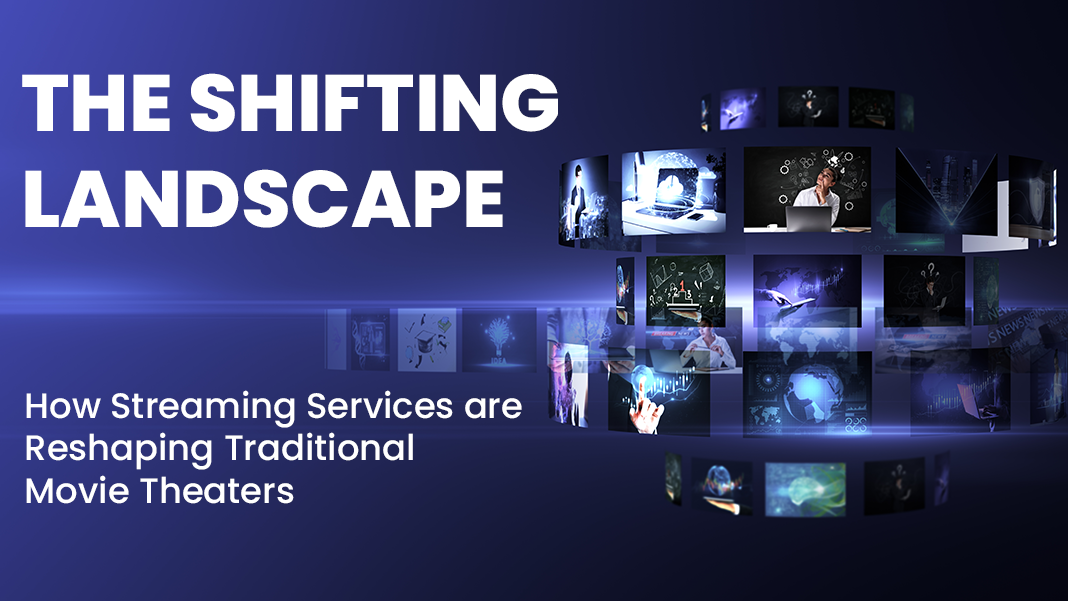The Shifting Landscape: How Streaming Services are Reshaping Traditional Movie Theaters:
Movies have been an integral part of our cultural heritage for numerous generations, captivating audiences with their imaginative worlds. Watching movies has become a commonplace activity in our lives. These internet-powered platforms are reshaping our perception of entertainment and revolutionizing the way we consume content. Traditional Movie Theaters are not much popular nowadays because of OTT platforms.
The days of relying on traditional TV channels and cable providers are long gone, as we now have the convenience of accessing a vast array of content on demand from the comfort of our own homes. With the availability of high-speed internet and affordable subscription prices, India’s OTT market has experienced a remarkable 20% growth in recent years. This trend has been steadily increasing over the years and has been further accelerated by the pandemic, with average daily viewership reaching two to three hours.
Transition to online streaming:
The transition to online streaming was not an overnight occurrence. Initially, platforms like Netflix had modest beginnings in 2007 and were not initially recognized as potential disruptors. But over a decade later, we now have a plethora of options to choose from, with numerous TV streaming services offering access to a wide range of television content and exclusive movies produced specifically for streaming.
The allure of subscribing to a streaming service lies in the vast library of content available at a fixed fee. We have become accustomed to binge-watching entire seasons in one sitting, thanks to online streaming. Additionally, movies produced by streaming services often boast high production quality, rivalling those created by major Hollywood studios.
What does this shift indicate for Movie Industry:
This shift in consumer behavior has led to online streaming surpassing traditional cinema attendance. The affordability of streaming services is a major factor contributing to this trend. While there are still exceptional movies exclusive to theaters, many individuals hesitate to pay for a cinema ticket when they have a convenient alternative available at home. Streaming offers a hassle-free experience and is particularly appealing to those who prefer the comfort of their own homes. Furthermore, the ability to easily switch between movies and shows is a luxury that traditional cinema cannot provide.
Resisting the demands of the audience is futile, so instead, they are embracing the opportunity to offer a wide variety of captivating content through online platforms. However, this does raise concerns for traditional movie theaters and their ability to retain customers in the face of increasing competition.
An innovative approach to promote the cinema experience:
To counter this challenge, theater chains are exploring innovative approaches to entice moviegoers and promote the unique experience of watching a film in a cinema. They are emphasizing the cinema experience as a luxury outing, complete with cutting-edge technology, comfortable seating, and gourmet refreshments. Additionally, subscription plans at fixed costs are being introduced, allowing customers to watch an unlimited number of movies within a month. These subscription options vary in price, catering to different locations and budgets. Given the rising cost of cinema tickets, offering such subscription plans is a welcome development.
While streaming services undoubtedly represent the future of the entertainment industry, the cinema experience still holds a distinct appeal. Through innovative strategies, theaters are aiming to attract audiences by providing an enhanced and immersive movie-watching experience.
The Impact of Streaming Services on Traditional Movie Theaters:
Rather than opting for conventional TVs, people now seek models equipped with remote sticks for seamless control of applications, enhancing the overall streaming experience. Furthermore, the advent of streaming services has resulted in a decline in traditional TV viewership. Viewers now have the convenience and flexibility to watch their favorite shows at their preferred time and location. This shift has influenced content production, with a greater emphasis on creating shows that are binge-worthy and feature a continuous storyline to keep viewers engaged.
The Future of the Industry:
Undoubtedly, streaming services will continue to have a profound impact on the TV industry in the future. As more consumers opt for streaming over traditional TV, the industry must adapt to avoid becoming obsolete.
Convenience and accessibility: The Impact on Movie Theaters and the Box Office:
With the rise of streaming services and the eventual release model, traditional movie theaters are facing significant challenges. As more viewers opt for the convenience of streaming and watching movies from their own homes, the footfall in theaters has declined. This decline in attendance has a direct impact on box office revenues and the profitability of movie theaters.
With movies being simultaneously released on streaming platforms, audiences now have the option to watch new releases from the comfort of their homes instead of going to the theater. This shift in consumer behavior has led to a decline in ticket sales and a decrease in box office revenues.
In response to this challenge, movie theaters have been exploring various strategies to attract audiences and enhance the theater-going experience. Some theaters have invested in advanced technologies such as IMAX and 4D to offer viewers a more immersive and unique experience that cannot be replicated at home. They have also focused on providing exceptional customer service, comfortable seating, and a wide range of food and beverage options to create a more enjoyable outing for moviegoers.
Additionally, theaters have started to diversify their offerings by hosting special events, film festivals, and screenings of classic movies. These initiatives aim to attract different demographics and cater to audiences looking for a more social and communal movie-watching experience that is distinct from home streaming.
However, despite these efforts, the competition from streaming services remains fierce. Moreover, the convenience and affordability of streaming services, coupled with the growing quality of home theater setups and sound systems, have made staying at home an attractive option for many viewers.
Collaboration between studios
As the movie industry continues to evolve, it is crucial for theaters to adapt and find innovative ways to stay relevant. Collaboration between studios, streaming services, and theaters is essential to create a sustainable and thriving movie ecosystem. This collaboration could involve exclusive theatrical windows for certain movies before their eventual streaming release, revenue-sharing models between streaming services and theaters, and joint marketing campaigns to drive audiences back to the big screen.
Many moviegoers value the unique experience of watching a film on a large screen, surrounded by fellow film enthusiasts. The communal aspect of movie theaters and the ability to immerse oneself fully in the cinematic experience are aspects that streaming services cannot replicate. By leveraging these advantages and embracing technology and innovation, traditional movie theaters can continue to attract audiences and remain an integral part of the movie industry.
The convenience and flexibility offered by streaming platforms have led to a decline in theater attendance and box office revenues. However, by adapting to changing consumer preferences, investing in innovation, and forging collaborations, movie theaters can navigate this new landscape and continue to provide captivating cinematic experiences for audiences in the future.
To wrap it up:
To sum up, the past decade has witnessed a revolution in entertainment consumption through the emergence of streaming services. India, propelled by government initiatives such as Digital India, has become a key player in the global OTT market. The availability of affordable subscriptions and high-speed internet has led to substantial growth in India’s OTT market, causing a shift in viewership habits. Traditional TV has experienced a decline as viewers increasingly opt for the convenience and flexibility of streaming platforms. This shift has prompted changes in TV purchasing patterns, content consumption habits, and content production strategies. However, traditional TV channels can still find opportunities by offering hybrid streaming services and focusing on creating exclusive, high-quality content. As the industry continues to evolve, the coexistence and mutual influence of traditional TV and streaming services will shape the future landscape of entertainment.











